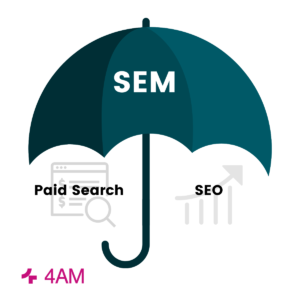

How to Use SEO for Demand Generation
First things first: let’s all get on the same page about SEO vs. Paid Search vs. Search Engine Marketing (SEM) vs. PPC. Because it can be confusing if you don’t live it everyday like I do. And, we get a lot of questions from clients that lead us to believe there’s some education and expectation setting that has to happen before demand generation teams can really harness the power of SEO.

Search engine marketing (SEM) is really an umbrella term that encapsulates both paid search and organic SEO (i.e. the traffic you don’t pay for – the results that appear below the ads in Google). Though, more recently, people are really referring to paid advertisements that appear on search engine results pages when they refer to SEM.
Paid search, also referred to as PPC (pay per click), is a large portion of digital marketing. Paid search works on a pay per click model, where search engines like Google allow companies to place ads on their results page but only pay if the ad results in clicks.
Search engine optimization (SEO) focuses on how you optimize your website in order to increase its visibility (aka: ranking) on search engine results pages when people are searching for terms related to your business or solution.
The best part about SEO – aside from time and the expertise, it’s something you can do for free to increase the awareness and visibility of your company. Also, the people searching for your target keywords are primed to hear your brand’s narrative or point of view because they’re indicating that they have a question or pain point related to your solution. This is a great time to introduce them to your brand.
Today’s blog is going to focus on how early-stage companies can leverage a solid SEO strategy for demand generation.
The Importance of SEO in Demand Generation
The main goal of demand generation is to build awareness and engagement around your product or service and convert that engagement into revenue. B2B marketers do this by targeting their ideal customer, meeting them where they are via a variety of channels, and presenting them with a narrative that connects pain they feel to new ways to solve that pain (i.e. YOU). Compelling content in all forms from web copy to blogs to advertisements to longer form content built on top of a solid SEO strategy play a critical role in pushing that narrative into the market.
There are a number of places your potential customer may turn to find ways to solve for the pain they have identified: colleagues, friends, their network, social networks, industry events or media, and, of course, search engines. It’s hard to even remember a time when you couldn’t simply pick up your phone and quickly type “how to cook a turkey” and be met with pages and pages of instructions for nailing your Thanksgiving dinner.
Aligning Search Intent to the Buyer’s Journey
This relates to people searching for business solutions as well. Intent matters. If I’m searching to learn, I’m going to click on the content that I believe will educate first and sell second (if at all). Conversely, if I have identified my pain and I’m searching for a solution, I’m going to click on content that will sell me on the best solution first, and not try to continue to educate me on the pain I feel.
That’s why one of the first things to consider when writing content for SEO is search intent. Search engines like Google are placing a larger emphasis on search intent rather than just keywords to increase the relevance of what they serve you. For example, if you search for “best commuter cars” you are probably expecting to see a list of commuter cars with some commentary on what makes them so great. But, if you search for “Toyota dealerships near me” you’re not looking for a list of the models Toyota offers, you’re looking for the location of the dealership.
Now, if we map intent to each stage of the buyer’s journey, we have a great way to align SEO with your content and demand generation strategy. Below are the different levels of search intent, and how they align to the buyer’s journey.
Informational
This is awareness. The main focus of your content should be to answer the question the searcher was looking for. This is your opportunity to frame the answer within the point of view of your brand, but aim to provide educational content that positions you as a subject matter expert rather than go straight to pitching your product. The key here is to answer the question in the point of view of your brand with your solution as a supporting character.
In our commuter car example this may be a time for Toyota to position its point of view on why hybrid cars are best for commuting, with a secondary nod to the Prius as a popular choice.
Blog articles, glossary pages and topical FAQ’s are popular forms of awareness content for SEO.
Commercial
This is consideration. In this case, the searcher has identified their pain and is beginning to search for what products they may consider purchasing to solve that pain. Your content here should provide the various options or ways to solve the problem, with yours as one of the options.
Our searcher looking for the best commuter cars may have identified that the cost of gas is their core pain and is now convinced that hybrid cars are the way to go. Now, they’re searching to understand which hybrid model is best for them. A popular way to search in the consideration stage is “Prius vs. Accord Hybrid” for example.
Comparatives lists, “this vs. that” analysis, and reviews are great forms of content for SEO in the consideration phase.
Transactional
This is the decision stage. Once you get to decision, the searcher has largely made up their mind and they are ready to gather their last few details and talk to sales. Your content in this stage needs to be product specific, answer key questions the searcher may have and must be optimized for conversion.
Our searcher looking for their commuter car now may be 90% of the way to their decision to purchase a Prius. Now they want to understand which trim packages contain which features, what the fuel economy is, and how often they’ll need to charge the battery.
Specific product pages with more detailed feature information are the best for SEO here. And, if your product addresses multiple pain points, it’s best to include pages for each on your website. Finally, because the buyer is close to making a purchase, make it very easy for them to talk to sales on each page.
Navigational
This is the purchase stage. The buyer now has made up their mind and is ready to purchase. They may be seeking details now on implementation, how to contact support, or even customer resources. For example, if you’re selling a SaaS solution to the security team, it may be smart to set up a page on your website that answers questions about the security of implementing your solution.
Or, in the case of our Prius buyer, they may be looking for inventory at local dealerships to narrow in on the best price point locally or which dealer has the trim + color combo they want.
Pricing pages, support pages or common product-specific FAQ pages are best for SEO in this stage.
There you have it. These are some core fundamentals to keep in mind when you’re planning your content to ensure it’s optimized for SEO. We could go on about this topic for pages and days, so stay tuned. We’ll come back soon to talk about specific tactics for setting up your website for SEO.
As always, let us know what you think. We help clients with SEO everyday so if you want to continue the conversation, we’re here for you.
We’d love to connect!
Interested in trying the 4AM Platform for free? Create an account and let us know what you think!


